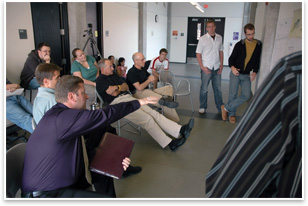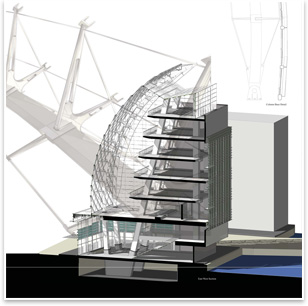Milwaukee Firm Sponsors Student IPD/BIM Studio
University of Wisconsin-Milwaukee's School of Architecture and Urban Planning integrates IPD, BIM into design studio
by Russell Boniface
Associate Editor
 How do you . . . combine into a curriculum integrated practice delivery lessons with hands-on BIM training? How do you . . . combine into a curriculum integrated practice delivery lessons with hands-on BIM training?
Summary: Milwaukee-based Eppstein Uhen Architects (EUA) sponsored for the fall 2008 semester the Integrated Practice/Building Information Modeling (BIM) Studio at the University of Wisconsin-Milwaukee's School of Architecture and Urban Planning (SARUP). The SARUP program is unique in that it combined both IPD and BIM into its design studio curriculum, which introduced Revit® BIM software to architecture students.
View the photo gallery
Photos courtesy of Eppstein Uhen Architects and the University of Wisconsin-Milwaukee School of Architecture and Urban Planning.
The IPD/BIM Studio at SARUP, Wisconsin's only architecture school, involved students with EUA staff, SARUP professors, and industry professionals. The studio was first sponsored by EUA for the fall 2007 semester as a way for the firm to increase its presence at the school. “We wanted to find a unique way to do it rather than making a donation or putting our name on one of the school’s studios,“ says Bret Tushaus, EUA vice president of information technology. “Our intent was twofold, because we also wanted to help influence the curriculum by making BIM a core part of it. Given the relevancy at that time of BIM and the momentum behind the concept, plus the fact that our firm was committed to it ourselves, we thought this was a unique way to introduce it to a school that really wasn’t aware of it.” He and his firm particularly wanted to teach Revit to the students.
A studio for one concept becomes a studio for two concepts
Students responded to the first iteration of the design studio. “The professors and I were so pleased with the outcome and the work produced by the students that we wanted to build on that success for fall 2008,” Tushaus says. “Our original push was BIM, but obviously the relevancy of IPD was on our minds as well.” EAU and SARUP wanted the studio to introduce students to the concept of IPD and how it ties into the concepts and technical skills of BIM.
 Explains Tushaus: “The premise is still the same in terms of introducing Revit, but we added consultants and professionals from the industry—a structural engineer, mechanical engineer, contractor—plus I participated myself as an architect. We integrated those individuals into the design phase early on and commented on the schematic aspects of the students’ design from the different disciplines’ perspectives. We gave some collective wisdom to where the students were going with their designs right from the start to ultimately create a more informed, more thought out, more complete design than a more traditional design studio setting.” Explains Tushaus: “The premise is still the same in terms of introducing Revit, but we added consultants and professionals from the industry—a structural engineer, mechanical engineer, contractor—plus I participated myself as an architect. We integrated those individuals into the design phase early on and commented on the schematic aspects of the students’ design from the different disciplines’ perspectives. We gave some collective wisdom to where the students were going with their designs right from the start to ultimately create a more informed, more thought out, more complete design than a more traditional design studio setting.”
Two UWM professors facilitated the six-credit studio course, while Tushaus took on an adjunct role to facilitate bringing in the consultants and engineers. An individual from EUA provided the technical instruction on Revit. So far, most of the students in the studio have been graduate students. Tushaus says he is hoping to tweak the IPD/BIM Studio for next fall to bring students on board at an earlier level in the curriculum.
 Helping students prepare for real-world design Helping students prepare for real-world design
Tushaus says that the design studio at the University of Wisconsin is fairly unusual among architecture schools because it combines IPD and BIM to get students involved with professionals who can help prepare them for the real world of architecture. “Traditionally the focus is design, and in many cases rightfully so,” he says. “The initial reaction to something like this is that it is going to be an obstacle to good design. I believe, and I think the professors and students would agree with me, that the IPD/BIM Studio turned out to produce better design. It allowed the students an opportunity to think through what they were doing in ways that traditionally were not possible.”
Tushaus recommends to firms looking to sponsor a design studio that they go into it with the intent of influencing what students experience and are taught to better prepare them for the real world. “Whatever that means,” he says. “The design, the tools, the construction technology—there are a lot of aspects."
| 


